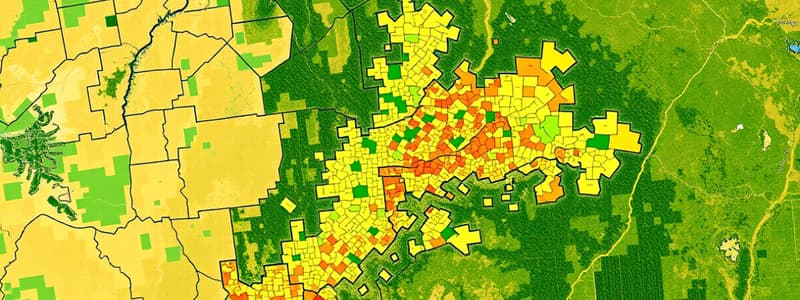Podcast
Questions and Answers
What is Agricultural Population Density?
What is Agricultural Population Density?
Number of farmers divided by the arable land
What is Arable Land?
What is Arable Land?
Land suitable for farming/agriculture
What is Physiological Population Density?
What is Physiological Population Density?
Population of a region divided by arable (farmable) land
What is Arithmetic Population Density?
What is Arithmetic Population Density?
What does Baby Boom refer to?
What does Baby Boom refer to?
What is a Census?
What is a Census?
What does the Child Mortality Rate indicate?
What does the Child Mortality Rate indicate?
What is Crude Birth Rate?
What is Crude Birth Rate?
What is Crude Death Rate?
What is Crude Death Rate?
What is the Dependency Ratio?
What is the Dependency Ratio?
What is a More Developed Country (MDC)?
What is a More Developed Country (MDC)?
What is Doubling Time?
What is Doubling Time?
What is Ecumene?
What is Ecumene?
What does the Epidemiological Transition Model describe?
What does the Epidemiological Transition Model describe?
What was the Industrial Revolution?
What was the Industrial Revolution?
What are Infant Mortality Rates?
What are Infant Mortality Rates?
What are Less Developed Countries (LDC)?
What are Less Developed Countries (LDC)?
What is Life Expectancy?
What is Life Expectancy?
Who was Thomas Malthus?
Who was Thomas Malthus?
What is the Malthusian Theory?
What is the Malthusian Theory?
What is the Medical Revolution?
What is the Medical Revolution?
What is the Rate of Natural Increase (RNI)?
What is the Rate of Natural Increase (RNI)?
What does Neo-Malthusian mean?
What does Neo-Malthusian mean?
What are Population Pyramids?
What are Population Pyramids?
What are Anti-Natalist Policies?
What are Anti-Natalist Policies?
What are Pro-Natalist Policies?
What are Pro-Natalist Policies?
What is the Sex Ratio?
What is the Sex Ratio?
What is the Total Fertility Rate?
What is the Total Fertility Rate?
What is Zero Population Growth?
What is Zero Population Growth?
What is Demography?
What is Demography?
What does Overpopulation mean?
What does Overpopulation mean?
What is a Population Center?
What is a Population Center?
What is the Demographic Transition Model?
What is the Demographic Transition Model?
What does Mobility refer to in geography?
What does Mobility refer to in geography?
What is Periodic Movement?
What is Periodic Movement?
Flashcards are hidden until you start studying
Study Notes
Population Density Terms
- Agricultural Population Density: Ratio of the number of farmers to arable land; indicates farming efficiency in a region.
- Physiological Population Density: Population divided by arable land, highlighting pressure on farmland.
- Arithmetic Population Density: Total population divided by the overall land area; gives a general density figure.
Land and Demographics
- Arable Land: Land that can be cultivated for crops; essential for food production.
- Demography: The scientific study focused on characteristics and statistics of populations.
Population Metrics
- Crude Birth Rate: Number of live births per 1,000 individuals in a year; reflects population growth.
- Crude Death Rate: Total deaths per 1,000 individuals; indicates mortality within a population.
- Child Mortality Rate: Represents child deaths per 1,000 live births; a measure of health and living conditions.
- Infant Mortality Rate: Number of infant deaths under one year per 1,000 live births; impacts life expectancy calculations.
Population Changes
- Baby Boom: A significant increase in birth rates typically following a major event (e.g. post-war).
- Doubling Time: Time required for a population to double in size; an important measure of population growth.
- Rate of Natural Increase (RNI): Percentage of annual population growth excluding migration factors; used for demographic analysis.
Socioeconomic Categories
- More Developed Country (MDC): Countries that have advanced socio-economic development, often with high living standards.
- Less Developed Countries (LDC): Less industrialized nations, typically facing economic and social challenges; often in early stages of demographic transitions.
Health and Technology
- Medical Revolution: Transition in the late 20th century in which medical advancements from developed countries enhanced healthcare in developing regions.
- Epidemiological Transition Model: Framework emphasizing different death causes at various developmental stages, explaining demographic shifts.
Theories of Population
- Malthusian Theory: Suggests that population growth will inevitably outpace food supply, leading to famine and societal stress.
- Neo-Malthusian: A modern reiteration of Malthus's ideas, stressing environmental degradation due to overpopulation and resource scarcity.
Population Control Policies
- Anti-Natalist Policies: Government actions aimed at reducing birth rates; can include education and family planning.
- Pro-Natalist Policies: Policies intended to encourage higher birth rates, often supported by incentives for families.
Additional Demographic Concepts
- Dependency Ratio: Comparison of non-working-age individuals (young and elderly) to the working population; affects economic planning.
- Life Expectancy: Average life span expected for an individual; serves as an indicator of healthcare and living conditions.
- Population Pyramids: Graphical representation of population distribution by age and sex; useful for understanding demographic trends.
Key Terms in Population and Migration
- Mobility: The general movement of populations, indicating patterns of migration and settlement.
- Periodic Movement: Temporary relocation often associated with seasonal work or education, such as students going to college.
- Overpopulation: Occurs when the population exceeds the environment's capacity to sustain equitable living standards.
- Ecumene: Regions of Earth that are inhabited and heavily populated.
Geographic Population Focus
- Population Center: Areas with high population density such as East Asia, South Asia, Southeast Asia, and Europe; indicates global population trends.
- Demographic Transition Model: Illustrates the transition from high birth and death rates to lower rates as a country develops economically and socially.
Studying That Suits You
Use AI to generate personalized quizzes and flashcards to suit your learning preferences.




